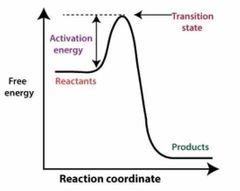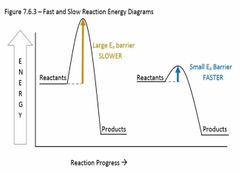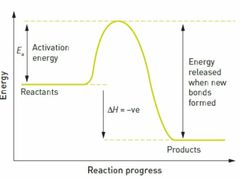![]()
![]()
![]()
Use LEFT and RIGHT arrow keys to navigate between flashcards;
Use UP and DOWN arrow keys to flip the card;
H to show hint;
A reads text to speech;
13 Cards in this Set
- Front
- Back
- 3rd side (hint)
|
What is collision theory |
Not all collision results are successful, for a successful collision the following must occur: - Collide with the correct orientation - Collide with sufficient amount of energy |
What makes a successful collision |
|
|
Activation energy |

Minimum amount of energy required for a chemical reaction to occur |
|
|
|
Activated Complex |
A temporary, unstable arrangement of atoms where old bonds are breaking and new bonds are forming after a successful collision |

|
|
|
How does activation energy affect rate of reaction |

The higher the activation energy, the slower the chemical reaction is. This is because molecules can only complete a reaction once they have reached the top of the activation barrier. The greater the total energy in the bonds, the more energy is needed to break them and start a reaction. |
Activation energy is related to bond energies |
|

Key features of energy profile diagram |
1. Left side of curve is the energy that must be absorbed to break the reactant bonds 2. Peak of the curve is the transition state where energy is at its greatest and the arrangement of atoms is most unstable 3. Right side of curve is the energy released when product bonds are formed 4. If reactants have more energy than the products then energy is released to environment (endothermic), therefore change in enthalpy between reactants and products is -∆H 5. If the products have more energy than the reactants then energy is absorbed from the environment (endothermic), therefore the change in enthalpy between the reacts and produces is +∆H |
5 features |
|
|
How does surface area affect rate of reaction |
Collisions with solid reactants only occur at the surface. Increasing the surface area of a solid increases the available space for collision to occur and therefore the frequency of collisions |
Increased surface area - solids only |
|
|
How do catalysts affect rate of reaction |
Catalysts are chemical substances that increase the speed of a chemical reaction without being consumed by the reaction. They provide an alternate reaction pathway with a lower activation energy. Lower activation energy = number of successful collisions increases for a given temperature. |
Activation energy |
|
|
What are the five factors that affect rate of reaction and how do they affect it |
Rate of reaction is dependent on frequency of collisions and energy of collisions - Temperature (frequency & energy of particles) - Pressure (frequency) - Concentration (frequency) - Surface are (frequency) - Catalysts (activation energy) |
List 5 factors |
|
|
How does concentration affect rate of reaction |
Increase in concentration = increase in number of particles. Higher number of particles = higher chance of reactants colliding. |
Increase in particles |
|
|
How does pressure affect rate of reaction |
Increase in pressure = number of gaseous reactants in a given space increases. Therefore, increases frequency of collisions. |
Gases only |
|
|
How does temperature increase the rate of reaction |
Increasing temperature of reactants = increase in kinetic energy. Therefore, more collisions occur with a greater amount of energy. |
kinetic energy |
|
|
What are catalysts |
- Enzymes are a biological catalyst (protein-based molecules that speed up biochemical reactions) - Solid substances such as platinum or iron - Metal nanoparticles |
|
|
|
How is rate of reaction measured |
Measured in change over time. Change can be: - Loss in mass go a solid reactant - Volume of gas generated - Formation of a solid precipitate - Change in colour Reaction rate = Change in quantity/time period |
List the changes (4) + the equation |

